Cut your Smart Net Bill in Half
Cut your Smart Net Bill in Half
Tredent provides maintenance support on networking and data center infrastructure with our TDS-NetCare offering.
Our solution has been designed to meet your budget and performance requirements while providing peace of mind at tremendous savings. These savings can then be allocated to another initiative within your IT budget.
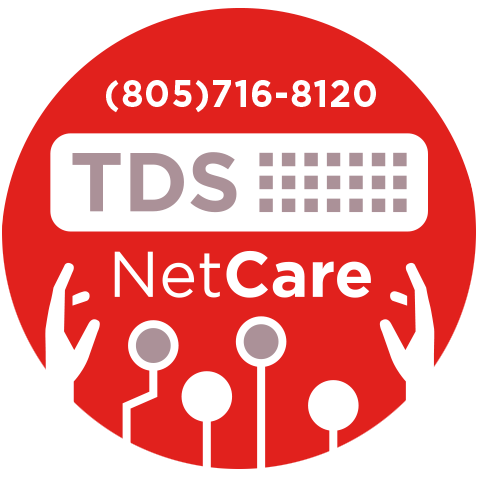
The purpose of this guide is to provide helpful information to owners of Cisco infrastructure considering Hybrid Maintenance, a Smart Net alternative, or Third Party Maintenance (TPM) on Cisco devices. Cisco’s software policies support our recommendation for Hybrid Maintenance. Smart Net is a valuable and excellent service. We recommend Smart Net for devices that REQUIRE Smart Net to legally obtain software updates.
Many Cisco devices are entitled to Free Software Updates Cisco offers Free Software Updates on many devices with LAN Base & IP Base Feature Sets.
Many Cisco devices no longer receive software updates - Many Cisco devices are End of Software Maintenance (EoSW). Typically after 4 years, and 4 years before End of Support (EOS), Cisco many times no longer develops software updates.
Cisco devices are entitled to Free Software Updates, and/or EoSW, we recommend using a qualified TPM to support these devices at a significant savings.
NOTE: “The terms “Cisco”, “Smart Net”, “Cisco Catalyst”, and “Smart Net Total Care”, are trademarks or trade names of Cisco Systems, Inc. & are used here for identification purposes only.
Cisco Smart Net Maintenance
is an award winning maintenance solution providing support for
Cisco infrastructure provided directly by Cisco Systems, Inc. the OEM (Original Equipment Manufacturer).
Third-party Maintenance (TPM) is a maintenance solution providing support for Cisco infrastructure by companies independent of the OEM
What’s Included:
• Technical support from a TAC (Technical Assistance Center)
• Advance hardware replacement, in as little as 2 hours
• Internetwork Operating System (IOS) software updates (Cisco devices
entitled to Free Software Updates)
• Access to online resources (Users of Hybrid Maintenance with a valid
Cisco Smart Net contract)
Because TPMs are focused on servicing customers (rather than selling hardware), they’re usually more responsive and able to offer faster access to advanced problem-solving support. Customers can expect case management to be more personalized with an experienced technician as their first point of contact. Their depth of knowledge is readily accessible, and research shows that a majority of companies switching to TPMs are quite happy. A vast majority of contracts that go from an OEM to a TPM stay with third party maintenance permanently.
OEMs often recommend upgrading perfectly functioning hardware assets as the warranty nears expiration. If you don’t, it means an expensive post-warranty maintenance contract and eventually a diminished or end to OEM support. If you have an aging and stable infrastructure or you’re running legacy software to maximize your ROI, you might prefer to keep your existing infrastructure. With a TPM, you can extend the life of your equipment and continue to service and maintain it well after it’s deemed end of service by the OEM.
Many organizations utilize equipment from multiple vendors and carry several OEM agreements. Each incurs overhead, requiring additional time (and paperwork) to juggle the contracts. With a TPM, companies can receive support for multiple manufacturers — all in one contract. Consolidating services allows you to gain efficiencies, save the hassle of dealing with multiple vendors, and rely on predictable costs. It also alleviates issues of finger pointing that can occur with multiple service providers.
TPMs are able to provide an array of services, allowing you to tailor maintenance packages to your specific needs, rather than a one-size-fits-all approach. This flexible approach allows you to eliminate unnecessary services and puts you in the driver’s seat when it comes to choosing solutions that best match your requirements and budget. TPMs can easily customize solutions—from making simple contract changes to offering flexible lengths of service or coterminous contracts. This aligns all of your agreements to one common expiration date.
The OEM business model relies heavily on developing and selling new equipment, so they guide customers toward technology refreshes rather than extending the asset lifecycle of those devices. Because of this, OEMs often increase the cost of after-warranty maintenance services year over year, even ending support for products before end of life. This can lead to costly and unnecessary upgrades for companies. With a TPM, you can extend the life of your system through maintenance and support at a much lower price point. The savings can be significant, often saving clients 70% off OEM support list prices.
Deciding whether to stay with an OEM, switch to a TPM, or engage in a hybrid approach is an important decision. Working with a member of the Service Industry Association (SIA) will ensure that you are partnering with a quality provider.
Just because third party maintenance costs less doesn’t mean you get less—although it’s important to use a premium-quality provider (more on that further below).
Hybrid Maintenance for Cisco is a “strategic blend” of Smart Net Maintenance & Tredent’s TDS-NetCare
Very simply Cisco Hybrid Maintenance is:
Managing a Cisco powered network, you know this all too well that Smart Net can be expensive. But you need access to those software updates! Of course TAC and hardware replacement is great, but you’re really paying high prices for Software Updates. We’ve heard it from customers hundreds of times. Cisco emphasizes the value of software updates as a major factor important to buying Smart Net. In Cisco’s commissioned Forrester Consulting study, “The Total Economic Impact of Cisco Smart Net Service”, found on Cisco’s website, “updates” is mentioned 11 times including this part of Executive Summary which we have highlighted.
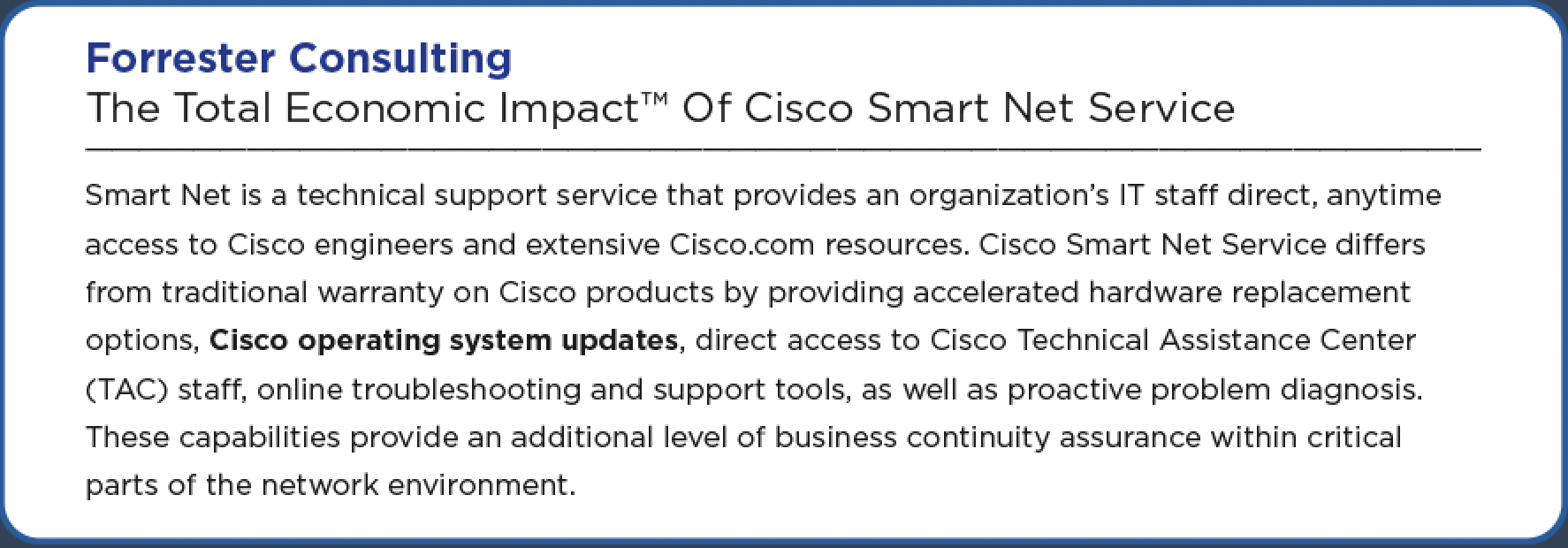
Further on in the study there is another common phrase related to Smart Net that has a lot of Cisco users confused about what software updates actually are.
Ongoing operating system (OS) software updates, including both minor and major releases within the licensed feature set.
We will clear this up in the next section with Cisco documentation but to give you something to think about before we get there.
Update means Cisco Software Maintenance Releases, Minor Releases and Major Releases.
In the below graphic from Cisco, the document Cisco Smart Net Service Overview emphasizes the value of Software Updates when buying Smart Net.
Cisco puts a lot of value on software updates when advocating the purchase of Smart Net. Cisco heavily markets the value of software updates that come with Smart Net and that value is justified by Cisco in the resulting high cost of Smart Net.
“Updates” includes ALL “releases” within the same feature set.
“Update” includes Major, Minor and Maintenance releases. We will let the Cisco’s Glossary of Terms do the talking. Here are the Cisco definitions:
This is a very important definition from Cisco’s legal service description
Update means Cisco Software Maintenance Releases, Minor Releases and Major Releases containing the same configuration or feature set as originally acquired. Cisco has 3 types of Software “Updates”
Any of these releases are considered software “updates” within the originally required feature set, which there are 6.
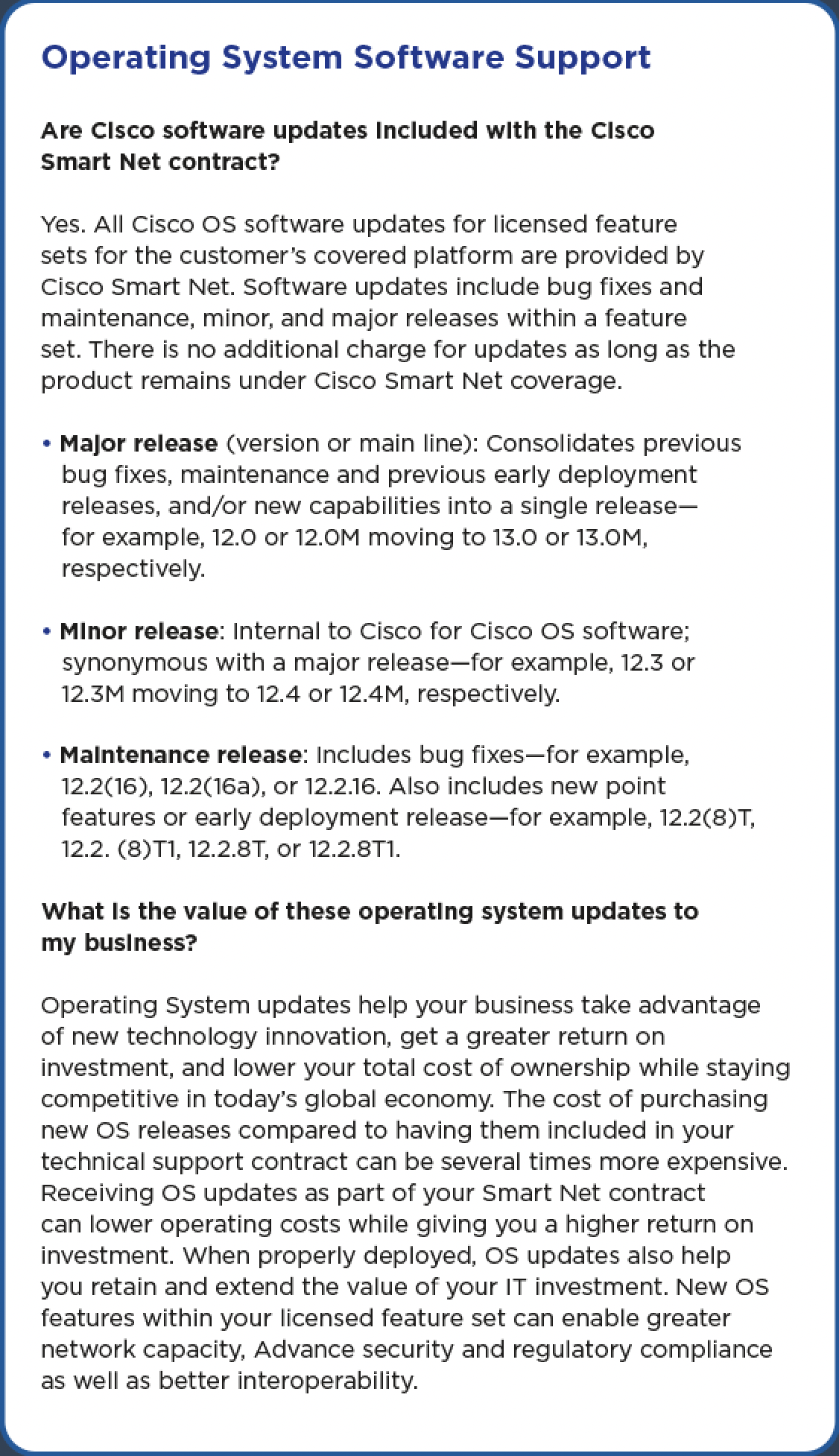
Information referenced from Cisco document ID: C67-713626-00 0812 Cisco SMARTnet Service: Q&A
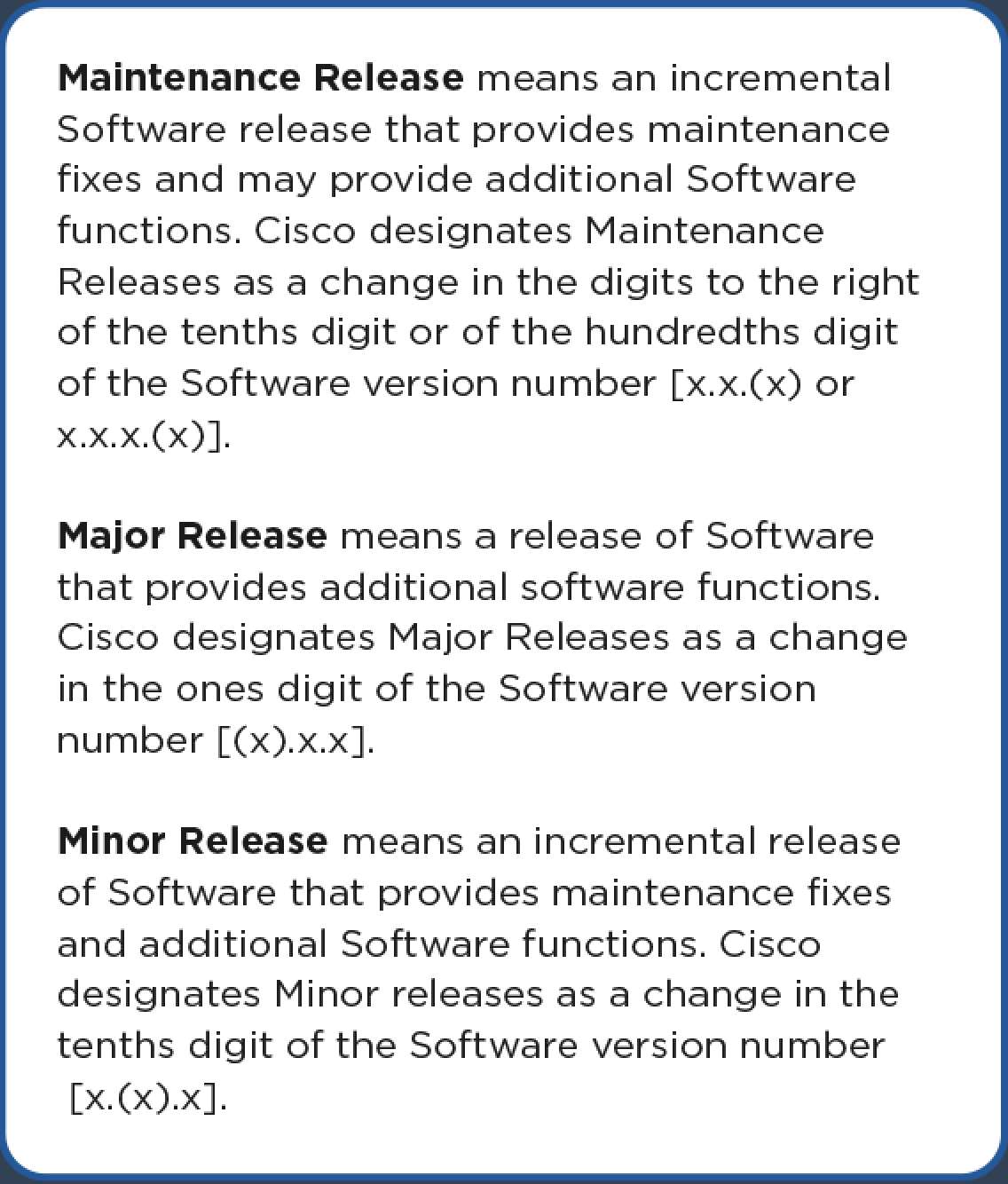
Information referenced from Cisco Glossary of Terms https://www.cisco.com/c/dam/en_us/about/doing_business/ legal/service_descriptions/docs/terms.pdf
Upgrades and Updates are very different. To move from one “feature set” to another would be considered an “Upgrade”. An “Upgrade” to a higher feature set is a separately licensed fee to all Cisco users whether the device has Smart Net or not.
To finalize what Cisco means by “Update”, it is clear that “Software Update” is 1 of the 3 available releases within the same feature set. Cisco’s document Cisco Smart Net Service Overview and the above graphic shows the 3 types of updates available.
In 2009, in response to the competition offering Free Software Updates on switches, Cisco began offering Free Software Updates on many devices for the LAN Lite, LAN Base, IP Lite and IP Base Feature sets. The announcement can be found on Cisco’s web site here - Cisco devices entitled to Free Software updates.
Pay close attention to the Software Entitlements listed below:

Information referenced from Cisco Document ID: 1469139439808554 Updated: July 21, 2016 https://www.cisco.com/c/en/us/products/collateral/switches/catalyst-4500-series-switches/product_bulletin_c25-696974.html
The term used in the entitlements from Cisco is Maintenance updates. The policy is exactly the same for Smart Net and no contract. Unlimited “Updates” is the important term here. We have already established “Update” covers all “releases”, of which there are only 3 types, major releases, minor releases and maintenance releases. Here is the definition of “update” again from Cisco’s Glossary of Terms.
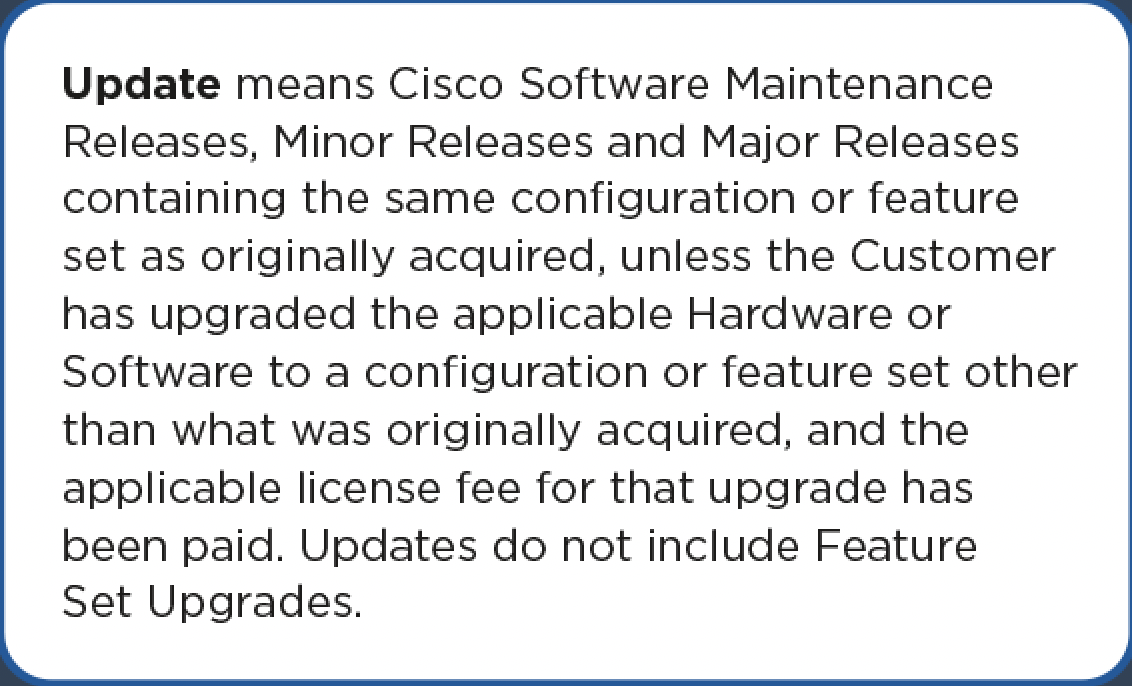
Information referenced from Cisco Glossary of Terms https://www.cisco.com/c/dam/en_us/about/doing_business/ legal/service_descriptions/docs/terms.pdf
As shown in the table above “updates” are free for LAN Lite, LAN Base, IP Lite and IP Base feature sets for all Cisco devices including Cisco Catalyst 4500, 4500E, 4500-X, 3850, 3650, 3750, 3750 v2, 3750 E, 3750-X, 3560, 3560 v2, 3560-C, 3560-E, 3560-X, 2960, 2960-C, 2960-S, 2960X, 2960-XR and 2960P.
When a device is entitled to Free Software Updates, we believe Smart Net is not a fiscally responsible choice vs. a qualified TPM solution like Tredent’s TDS-NetCare. We recommend considering Hybrid Maintenance on all devices entitled to Free Software Updates under this Cisco Policy.
2017 Cisco Catalyst IOS Software Update 9300 9400 & 9500 Series Switches
2017 Cisco Catalyst IOS Software Update 2000, 3000, & 4000 Series Switches
As of April 2019, Tredent has identified 221 Cisco devices that are entitled to Free Software Updates.
Click Here to see the list of 221 Devices Entitled to FREE Software Updates
Most Cisco owners are unaware that many Cisco devices stop receiving software updates 4 years after the First Customer Release (FCS) of the product. Cisco has a name for this date, “End of software maintenance releases date.”
The Cisco definition of the End of Software maintenance releases date:
“The last date that Cisco Engineering may release any final software maintenance releases or bug fixes. After this date, Cisco Engineering will no longer develop, repair, maintain, or test the product software.”
Information highlight is referenced from End of Product Life Cycle: Overview https://www.cisco.com/c/en/us/products/eos-eol-policy.html
After the EoSW date Cisco will no longer provide software updates for a particular device. In the following graphics taken from Cisco’s web site you can see that Cisco is no longer providing software updates after year 4 (48 months). You can also see very clearly that from months 48-96 Cisco is providing “Cisco TAC Support Only” for devices past the EoSW date. Cisco continues to recommend Smart Net for devices after the EoSW date up till the End of Support at month 96.
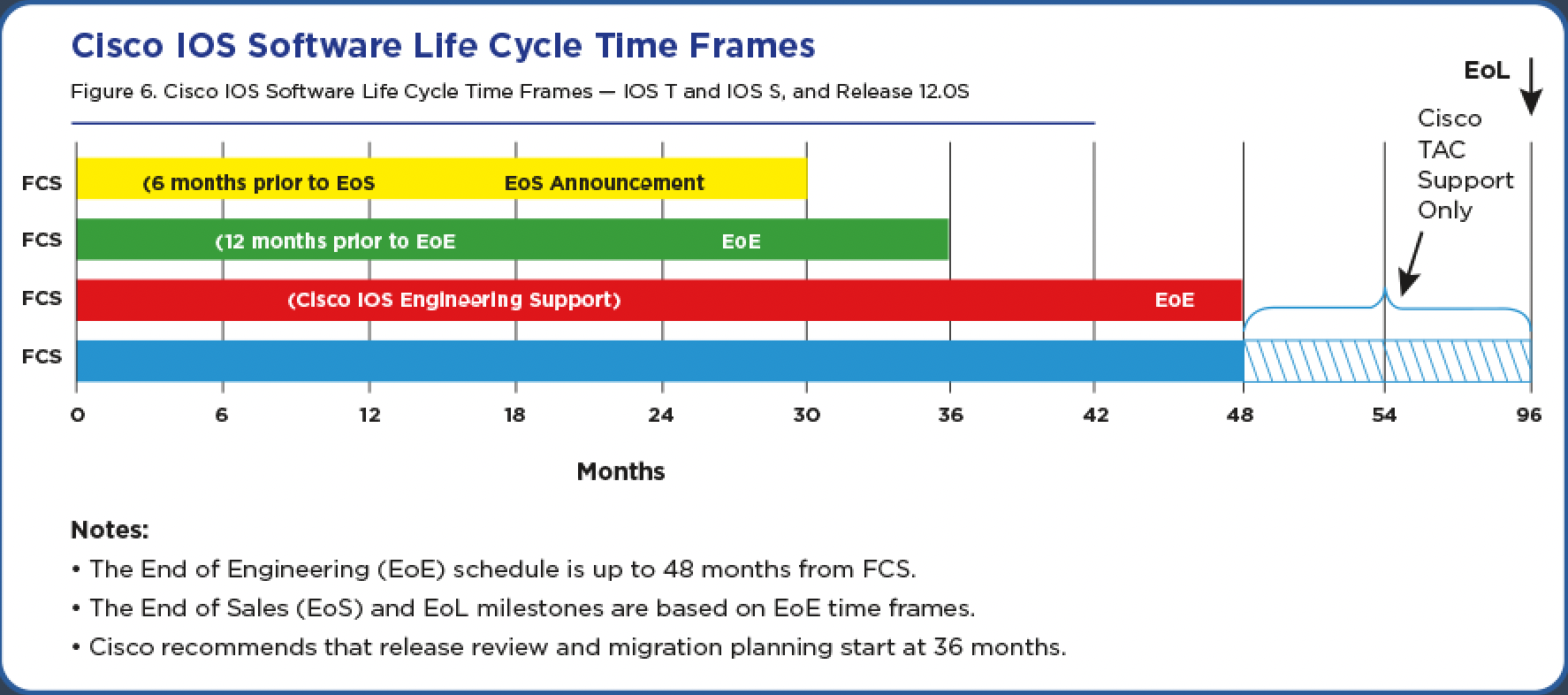
Image referenced from Cisco document C11-719867-01 07/16 Cisco IOS Software Reference Guide
The diagram below shows the typical phases and milestones in the lifecycle of a software release.
The image below is a highlighted snapshot of a typical Cisco End of Sale Announcement. Take notice of the 4-year difference from EoSW to Last Date of Support.
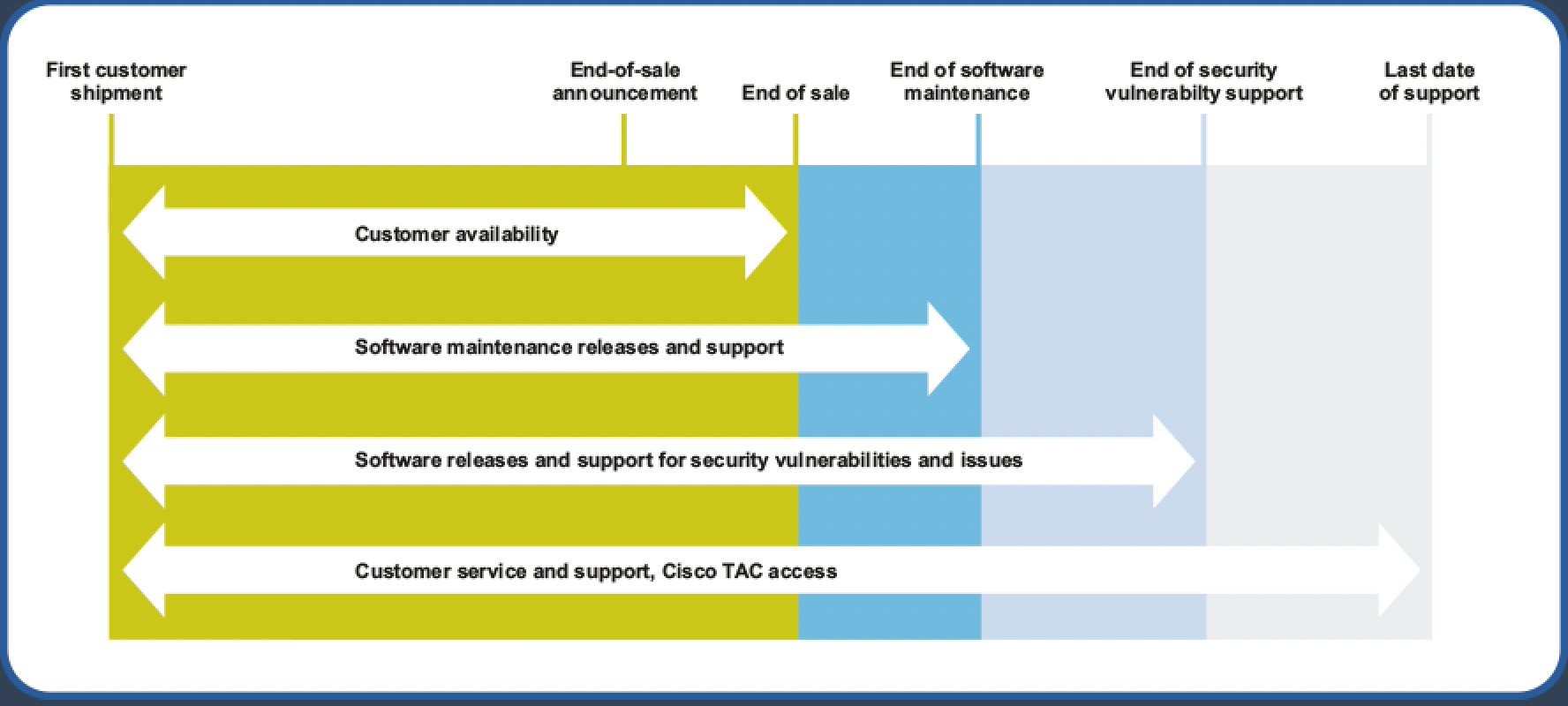
Information highlight is referenced from Cisco IOS and Cisco NX-OS Software Release Reference Guide https://tools.cisco.com/security/center/resources/ios_nx_os_reference_guide
The last day when Cisco Engineering may release any final software maintenance releases or bug fixes for the release. After this date, Cisco Engineering stops developing, repairing, maintaining, and testing the release; support for the release is provided via supported successor releases.
The image below is a highlighted snapshot of a typical Cisco End of Sale Announcement. Take notice of the 4-year difference from EoSW to Last Date of Support.
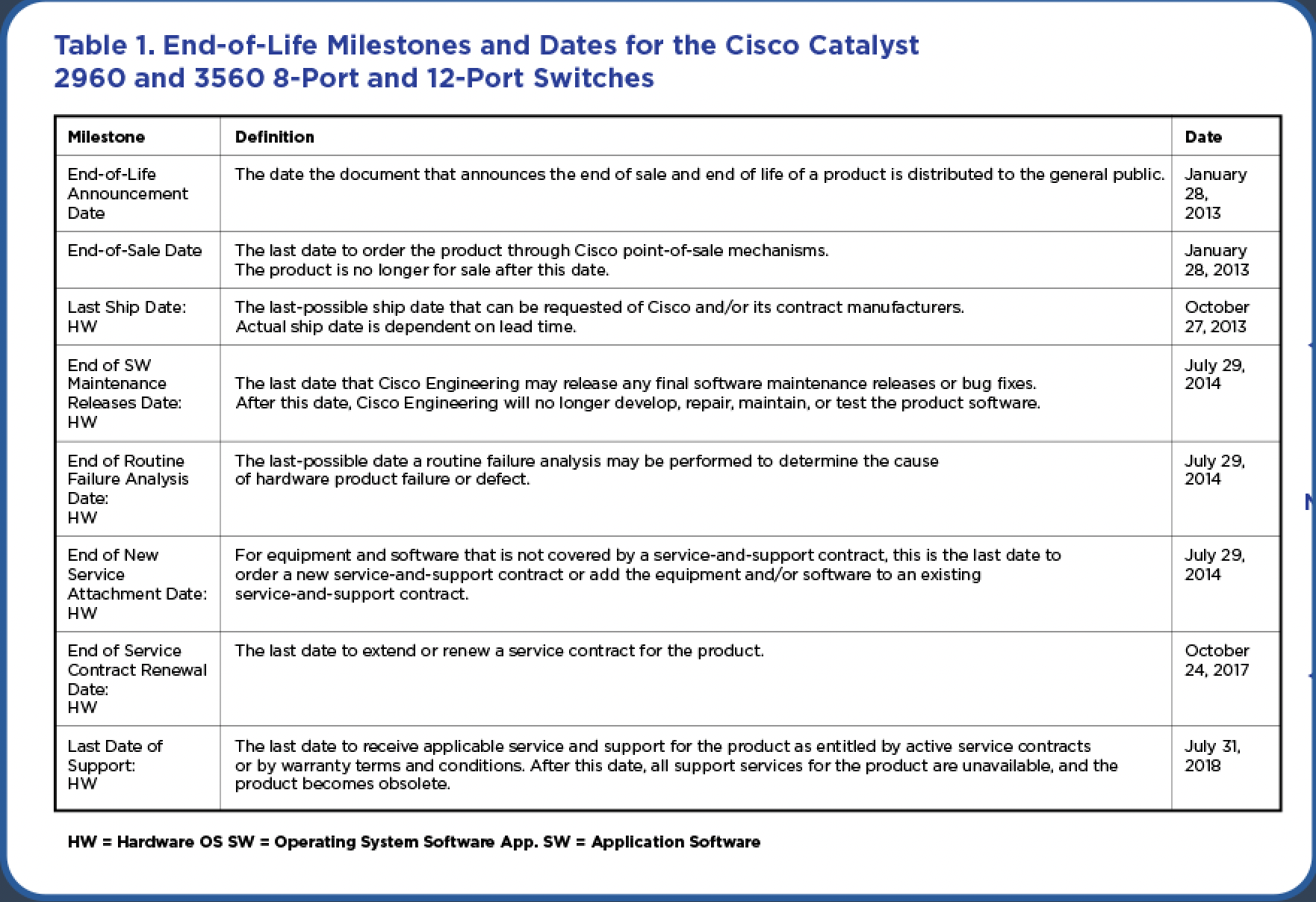
Information referenced from End of Sale End of Life ID: 1518503012870275 Updated: January 28, 2013
CLICK HERE End-of-Sale and End-of-Life Announcement for the Cisco Catalyst 2960 and 3560 8-Port and 12-Port Switches
One last reference and direct language about the Cisco EoSW policy taken from the below link regarding Cisco IP phones called the Cisco IP Phone Firmware Support Policy (Document ID: 116684)
“When a phone reaches End of Software Maintenance (EoSW), it means that Cisco is not obligated to release any further software updates for that model. There might be exceptions made for critical vulnerabilities, but these are always evaluated on an individual basis. The Cisco TAC will work on cases for products that have reached EoSW, but if a problem is discovered with the phone software, it will not be fixed.”
Information highlight is referenced from Cisco Document ID: 116684 Cisco IP Phone Firmware Support Policy Updated: December 17th, 2013
EoSW is an important milestone when considering maintenance options for Cisco equipment. After the EoSW date, Cisco is not providing the full service value of Smart Net and Smart Net is not a fiscally responsible choice. We recommend TPM on most devices past their EoSW date.
CLICK HERE Cisco IP Phone Firmware Support Policy
Customers considering Hybrid Maintenance options should be aware of the Cisco Policy relating to Security Vulnerability. We have highlighted the link and QR Code important and pertinent parts of the policy below from the Security Vulnerability Policy
Here is the language from the Incident Response Eligibility section of the Policy https://tools.cisco.com/security/center/resources/security_vulnerability_policy.html
Incident Response Eligibility
Customers with service contracts receive incident response assistance for any incident in which a Cisco product plays a significant role, regardless of whether there is an identified problem with a Cisco product.
All customers, regardless of contract status, receive free incident response assistance, similar to that offered to contract customers, for any incident that involves a known or reasonably suspected security vulnerability in a Cisco product.
Cisco reserves the right to determine the type and degree of assistance it may offer in connection with any incident and to withdraw from any incident at any time. Cisco may offer customers incident response services free of charge. Cisco may give special consideration to security incidents that involve actual or potential threats to persons, property, or the Internet as well as requests from law enforcement agencies or formal incident response teams.
CLICK HERE Security Vulnerability Policy
PSIRT will investigate and disclose vulnerabilities in Cisco products and services from the date of First Commercial Shipment (FCS) to the Last Day of Support. Cisco customers with service contracts that entitle them to regular software updates should obtain security fixes through their usual update channels, generally from the Cisco website. Cisco recommends contacting the TAC only with specific and imminent problems or questions.
“As a special customer service, and to improve the overall security of the Internet, Cisco may offer customers free software updates to address high-severity security problems. The decision to provide free software updates is made on a case-by-case basis. Refer to the Cisco security publication for details. Free software updates will typically be limited to Cisco Security Advisories.”
Information highlight is referenced from Cisco Security Vulnerability Policy https://tools.cisco.com/security/center/resources/security_vulnerability_policy.html
If Cisco has offered a free software update to address a specific issue, non-contract customers who are eligible for the update may obtain it by contacting the Cisco TAC using any of the means described in the General Security-Related Queries section of this document. To verify their entitlement, individuals who contact the TAC should have available the URL of the Cisco document that is offering the update.
CLICK HERE General Security Related Queries
After the End of Sale, the availability of security fixes provided by Engineering is defined in the product’s End of Sale bulletin. (See the End-of-Life Policy for details.) The End of Sale Bulletin may define one or more of the following milestones.”
Note: If the End of Security and Vulnerability Fixes milestone is not defined, the End of SW Maintenance and End of Engineering Support milestones will determine the last date Cisco Engineering will provide fixes.
All aspects of this process are subject to change without notice and on a case-by-case basis. No particular level of response is guaranteed for any specific issue or class of issues.
Cisco does an excellent job with Smart Net and some devices should ALWAYS have a Smart Net contract.
Send your list of Cisco devices to get our Hybrid Maintenance for Cisco recommendations.
The headline and subheader tells us what you're offering, and the form header closes the deal. Over here you can explain why your offer is so great it's worth filling out a form for.
Remember:

31312 Via Colinas Unit 106
Westlake Village, CA 91362
Phone: 805-375-4911
info@tredent.com
© 2024 Tredent Data Systems All Rights Reserved | Cisco® and the Cisco® logo are trademarks or registered trademarks of Cisco®